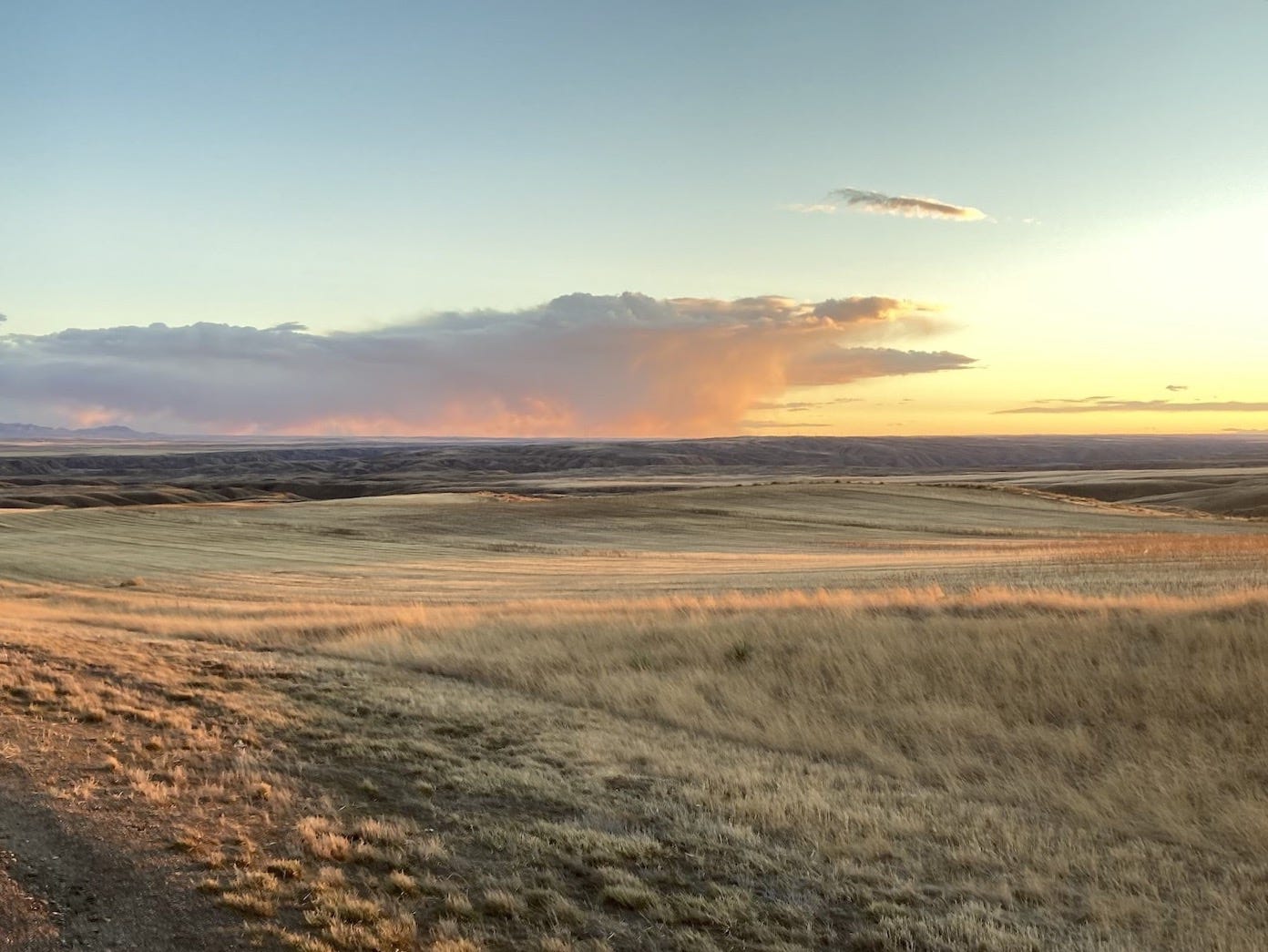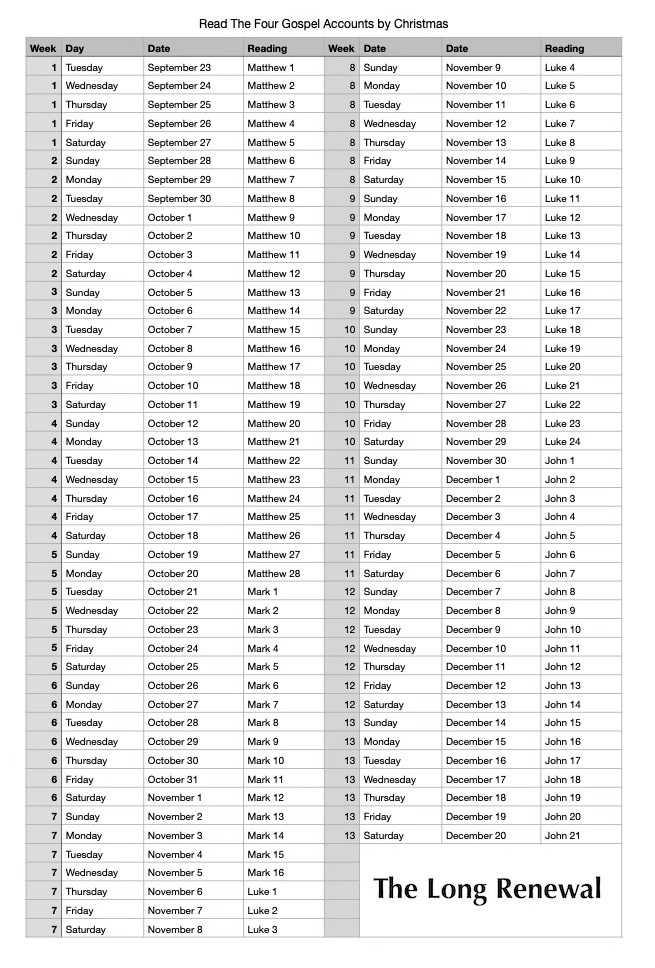I’m the type who cringes at the arrival of Christmas decorations on store shelves. It’s a timing thing. The leaves haven’t even fallen yet!
That said, I’ll gladly start getting ready to celebrate Jesus’ birth. To that end, this post kicks off a Bible reading plan. It will guide you through the gospel accounts of Matthew, Mark, Luke, and John by Christmas.
What better way to spend the fall than rediscovering Jesus? What better preparation for the arrival of a newborn King?
Feel free to download the plan, print it off, and tape it to your fridge. Or save it to your phone. Or bookmark this page and return to it right here. Whichever works best for you.
You need only read one chapter per day. It’s a pace that invites you to success. If you do fall behind, you won’t feel buried, as you can with more aggressive plans. If you read ahead, you could even carve out a day for revisiting standout passages. And for digging into the questions that Scripture’s sure to raise. One chapter per day offers that flexibility.
And persistence, in my view, is much more important than quantity.
That principle applies to Bible memorization too. Wait, say what? Yes, I’m also encouraging you to commit God’s Word to heart. Just below the reading plan is a single verse to get you started. Before long, you’ll join with the psalmist in saying, “I have stored up Your Word in my heart, that I might not sin against You.”1
The Reading Plan
The M-Word
This week, try memorizing John 1:1.
It might seem like I should choose a verse from Matthew, since that’s where our reading starts. But I’m playing the long game. Week by week, we’ll commit John’s opening verses to memory. Then, by the time we actually get to John at the end of November, you’ll already know the intro by heart.
In the beginning was the Word, and the Word was with God, and the Word was God.
I’m quoting the ESV. Feel free to use your preferred translation.
In the spirit of Deuteronomy 6, you could bind this verse as a sign on your hand, wear it on a decorative band on your forehead, and write it on the doorposts of your house.
You may also find modern wonders like sticky notes and notecards helpful.
A World Without Sin
The Gospel According to Matthew opens with a family history. This genealogy presents Jesus as the fulfillment of Israel’s long, winding story. And what has the One who fulfills Israel’s hopes come to do? An angel of the Lord soon makes this clear.
[Mary] will bear a son, and you shall call His name Jesus, for He will save His people from their sins. (emphasis mine)
Matthew 1:21
Jesus came into this world to save His people from their sins. We could add plenty of texture and color to that statement. We could, in other words, say much more about Jesus’ purpose. But we can’t say any less. And if we ignore this truth, or gloss it over, we’ve lost the plot.
A crucial teaching can lose its electricity with time. We need the Holy Spirit to reawaken our awe again and again. We have to stay astonished that Jesus saves.
It’s said that a zealous individual once approached a well-known Christian and asked, “Are you saved?” The believer confidently replied, “I am saved. I am being saved. And, by God’s grace, I will yet be saved!” In the first version of this story I came across, D.L. Moody was cast as the believer of renown. In the next, it was Bishop Foss Westcott. In other words, the story itself might be bogus. But its point remains entirely true.
If you’re a believer, at some time in the past, Jesus rushed in to save you from the consequences of your sins. You trusted that He died in your place and then rose from the grave. You might say that He opened your blind eyes. Or that you were born again. You might recall experiencing what the well-worn hymn Amazing Grace calls “the hour I first believed”—or you might not. But something definitely happened. God really raised you from spiritual death to everlasting life. Jesus saved you.
Jesus is still saving you. The author of Hebrews urges those who’ve already professed faith to “draw near to the throne of grace, that we may receive mercy and find grace to help in time of need.”2 Relatedly, the Apostle Paul reminds the church at Corinth that the Lord is slowly reshaping them into the likeness of Christ. The apostle describes this process as proceeding gradually, “from one degree of glory to another.” Jesus saved you yesterday. He’ll save you again tomorrow. And after each deliverance, your life will radiate just a little more of His holy character.
You’ve been saved. You’re being saved.
And the most astonishing rescue is still yet to come.
It doesn’t matter how many times I read Revelation 21. Its glimpse of a fully renewed world still gives me shivers.
And I heard a loud voice from the throne saying, “Behold, the dwelling place of God is with man. He will dwell with them, and they will be His people, and God Himself will be with them as their God. He will wipe away every tear from their eyes, and death shall be no more, neither shall there be mourning, nor crying, nor pain anymore, for the former things have passed away.”
Revelation 21:3–4
Here and now, our thoughts can leap into the gutter without warning. Regrets can lurk, ready to crush us. Every new day brings fresh sins to confess.
But someday every one of those will vanish like a strange mist. They will be extinguished by God’s holiness. And in that moment, we will step into an existence so wonderful that, at present, we can barely fathom it. No sin. No sorrow. No death. No pain. Every cruel trace of the Fall will be swallowed up in the tangible presence of the Lord of love.
Forever.
A one-hundred-year life on this earth will then seem but a flicker. A fleeting and forgettable glint.
I don’t think we reflect on this enough. One day God will dwell with His people. He will do so in the fullest possible sense, and that will never change. For those in Christ, the time will come when ninety-nine percent of our existence will have been free of sin. Even then, our new era will be in its infancy. Everything we will experience—perhaps all we’ll remember—will be infused with the Lord’s shalom.
It’s this perspective that allows the Apostle Paul to view great suffering as a “light, momentary affliction.” One that is preparing God’s people “for an eternal weight of glory beyond all comparison.” The key to this outlook, Paul tells us, is to “look not to the things that are seen but to the things that are unseen.”3
The gospel accounts are an invitation to see into the unseen. Their portrait of Jesus reveals the Savior in ever-startling clarity. We’ll follow in His footsteps in the coming months. We’ll look into His face. As we do, my prayer is that you will remember, where He is leading us, endless joy awaits.
Psalm 119:11
Hebrews 4:16
2 Corinthians 4:17–18




